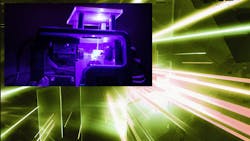A research team at Columbia University’s School of Engineering did a little out-of-the-box thinking and turned the laser upside down inside an SLS 3D printer so that it points up. The team also replaced the conventional tray of powder material with a borosilicate glass plate.
To make a test part, the researchers put down a measured amount of polymer powder on top of the glass pane. A substrate is pressed down on top of it, then a blue laser traces out the top layer or slice of the part being created. The laser fuses the powder into a solid layer and it attaches itself to the substrate. When that layer is complete and sufficiently cooled, the substrate is lifted, bringing with it the newly created layer, and some more powder is placed on the glass. The substrate is put back on top of the glass and powder, then a second layer is added. This process is completed until the part is finished. (To see this technique in action, watch the video below.
The team also created parts with sections made of two different fused powders. They just changed the type of powder used for several layers. This not practical with conventional SLS powder bed machines because the powders mix too much. The process can also be adjusted to print two different materials in the same layer. This involves making a partial layer, then lifting it and the substrate onto another printer to add to that layer with a different material.
The inverted process solves a couple other problems associated with convention. For example, to ensure all the powder gets sintered using SLS, the entire bed of powder must be heated to near-melt temperatures. This causes chemical and physical changes that make the material unpredictable and some powder not getting fused. The unfused portions can go undiscovered until the “finished” part is lifted from the powder bed and portions of it crumble.
With the inverted method, there are much fewer unfused particles, and any errors or defects are discovered almost instantly as all layers can be seen during the process.
To test their new method, the team built a 50-layer-thick, 2.18-mm sample using a mix of Sinterit white TPU and Sintratec PA12 thermoplastic. Layers averaged ∼71 μm thick, and parts were all nearly the same in thickness.
The researchers are confident their method can be used to make stronger, denser materials. Now they will be working on a better printer with automatic powder deposition and optimized laser parameters, in addition to experimenting with a wider range of materials.
“This technology has the potential to print embedded circuits, electromechanical components and even robot components,” says Hod Lipson, a researcher on the project. “We think this will expand laser sintering towards a wider variety of industries by enabling fabrication of complex multi-material parts without assembly. In other words, this could be key to moving additive manufacturing from printing only passive uniform parts towards printing active integrated systems.”
